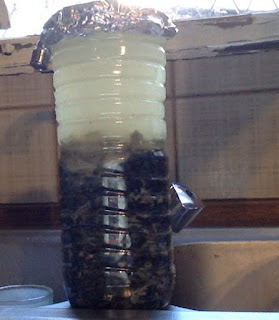Our names are Vasiliki Papadimitriou and Nikos Danavaras and we are presenting our results from Winogradsky column experiment, from day 12 to day 39.
03/04/2016
01/04/2016
In the twelfth day the water is turbid and its colour has become green. The water level is in the same level as it was the previous days and we can also see the thick white line in the middle of our bottle. The sediment continious becoming darker and this is the first day our experiment presents an intense odour.
03/04/2016
03/04/2016
In the fourteenth day our bottle has pretty much the same occurance except from the water level which is higher and has reached the surface of the bottle. We can also see that the surface layer is thicker.
04/04/2016
04/04/2016
In the fifteenth day the water level is much lower compared with the previous day and we can see that the white line in the middle of our bottle has disappeared. We can also observe that the protective film in the surface of our bottle has pulled inwards.
06/04/2016
In the seventeeth day we can see that various residues in the top of our bottle have disappeared and that the water is less turbid and its colour is no longer green.
11/04/2016
In the twenty second day the water is more turbid and its colour has become green and light purple.
13/04/2016
In the twenty foutrth day the only difference we can observe is the water colour which has become purple and is explained by the presence of photosynthetic microorganisms.
16/04/2016
16/04/2016
In the twenty seventh day the water colour is darker purple and the water level is higher compared with the previous days. We can also see that the protective film in the surface of our bottle has pulled inwards, so much, that the shape of our bottle has changed.
21/04/2016
In the thirty second day the water colour is still purple but in the middle of the bottle, the water is darker and more turbid than in the top of the bottle.
28/04/2016
Today (39th day) we can see that the water is very turbid and its colour has become dark pink. We can also see that our sediment has started becoming purple, like the water was the previous days.











































